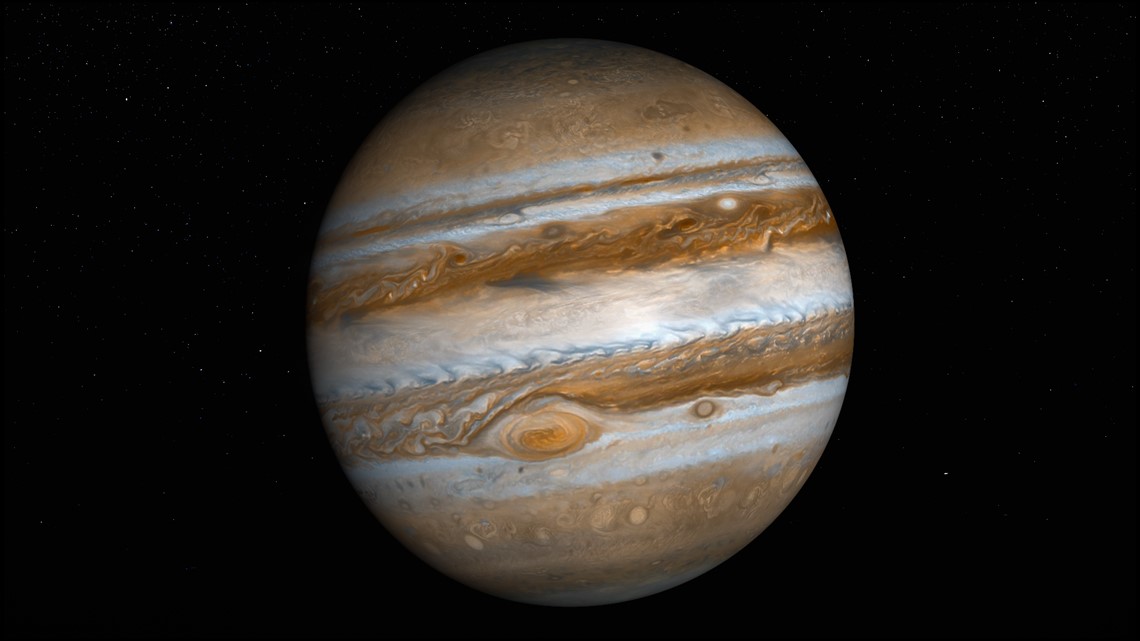Experts say you’ll need a large telescope to see the Red Spot, but even good binoculars will be enough to catch some details.
Stargazers have two good reasons Jupiter Monday evening.
NASA says the gas giant will reach opposition – rising in the east as the sun sets in the west – making it larger and brighter than usual for those who have a clear sky.
Jupiter’s opposition occurs every 13 months, but it coincides with a far more unusual event on Monday: the planet’s closest approach to Earth since 1963.
“Jupiter’s approach to Earth rarely coincides with opposition, meaning the views will be unusual this year.” NASA writes on its blog.
A close approach occurs because the planets do not revolve around the Sun in perfect circles, bypassing each other at different distances. At its farthest point, Jupiter is about 600 million miles from Earth. When it makes its closest approach on Monday, it will be about 367 million miles away, according to NASA.
How to watch a Jupiter opposition:
So will you be able to see Jupiter’s famous streaks and swirls? NASA astrophysicist Adam Kabelsky said good binoculars should allow you to see some of the bands and three or four of the planet’s many moons. A larger telescope will show you more details about Jupiter’s bands and the Great Red Spot.
“Viewings should be excellent for several days before and after September 26,” Kabelsky said in a NASA blog post. “So take advantage of the good weather either side of this date to see the spectacle. Outside of the Moon, it must be one of (if not the) brightest objects in the night sky.”
RELATED: NASA has released stunning pictures of Neptune and its rings with the help of the Webb telescope
Earth’s moon, which will make faint details in the night sky difficult to see in its full state, will be close to new Monday night — new moon is on Sunday.
Kabelsky said a dark, dry, high-altitude location would be best for stargazers who enjoy the spectacle. Whether you use binoculars or a larger telescope, stability will be key.
That’s not all!
This is a busy week for Jupiter. NASA’s Juno spacecraft, which orbited the gas giant for six years, come within 222 miles of Jupiter’s icy moon Europa. Researchers hope Juno will be able to capture the highest resolution images of the moon’s surface ever taken and gather valuable data.
Europe is one of four”Galilean satellites” — the largest satellites of Jupiter, discovered in 1610 by the famous astronomer Galileo. Scientists predict that beneath the icy surface of Europa lies a salty ocean.
Juno has been sending back images of Jupiter and its moons for years, but NASA recently unveiled one unprecedented pictures planets from the James Webb Space Telescope. Artificially colored infrared images captured Jupiter’s northern and southern lights, the Great Red Spot and countless smaller storms.
Juno’s mission will continue until 2025 or until the end of the spacecraft’s life.
NASA’s next big plan to explore Jupiter is the Europa Clipper, a spacecraft that will explore Europa in nearly 50 flybys and see if its conditions can support life. There is a craft is going nowthe launch of which is planned for 2024.
https://www.wtol.com/article/news/nation-world/jupiter-opposition-close-approach/507-1abf8a25-79c9-408d-a550-d133e3eb3fe4




